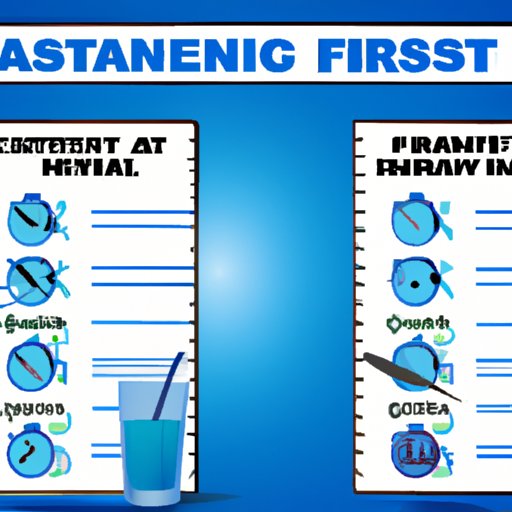Introduction
Fasting diets have become increasingly popular in recent years as a way to improve one’s overall health and wellbeing. The concept of fasting has been around for centuries and is still practiced today by many cultures and religions. The modern interpretation of fasting diets, however, is much more scientific and tailored to individual needs. This beginner’s guide will explore the different types of fasting diets, their associated health benefits, and how to incorporate them into your lifestyle.
A Beginner’s Guide to Fasting Diets
Before diving into the specifics of fasting diets, it is important to understand the basics of what fasting is and what it is not. Fasting is simply abstaining from food or drinks for a period of time. It does not necessarily mean eating nothing, but rather, reducing calorie intake for an extended period of time.
What is Intermittent Fasting?
Intermittent fasting is a type of fasting diet wherein individuals cycle between periods of eating and not eating. This type of fasting typically involves eating only during certain hours of the day or days of the week. For example, an individual may choose to fast for 16 hours and eat during the remaining 8 hours each day. Another popular type of intermittent fasting is the 5:2 diet, where people eat normally for five days and then fast for two days a week.
Benefits of Intermittent Fasting
Intermittent fasting has been shown to provide numerous health benefits. According to a study conducted by the National Institutes of Health, “intermittent fasting has been found to reduce body weight, lower blood pressure, reduce inflammation, and improve blood sugar levels.” Additionally, research has also suggested that intermittent fasting can help to reduce the risk of heart disease, stroke, and other chronic diseases.

How to Incorporate Fasting Into Your Diet
If you are interested in incorporating fasting into your diet, there are a few key strategies you should follow. First, it is important to find a fasting diet that works best for your lifestyle. There are several different types of fasting diets, such as the 16:8 diet, the 5:2 diet, and alternate-day fasting. It is important to find the one that fits your lifestyle and dietary needs.
Types of Fasting Diets
The 16:8 diet is the most common type of intermittent fasting. This type of diet involves fasting for 16 hours and eating during the remaining 8 hours each day. The 5:2 diet involves eating normally for five days and then fasting for two days a week. Alternate-day fasting involves alternating between days of eating and days of fasting.
Strategies for Successful Fasting
Once you have chosen a fasting diet, it is important to develop strategies that will help you stay on track. It is important to plan ahead and think about what foods you will eat during your eating window. Additionally, it is important to stay hydrated and get enough sleep while fasting. Lastly, it is helpful to keep a food journal to track your progress and adjust accordingly.
What to Expect When Starting a Fasting Diet
When starting a fasting diet, it is important to be aware of the potential challenges you may face. Some people experience hunger, low energy levels, and difficulty concentrating when starting a fasting diet. Additionally, it can take some time to adjust to the new eating schedule.
Common Challenges
As with any new diet, it is important to be aware of the potential challenges you may face when starting a fasting diet. Some people experience hunger, low energy levels, and difficulty concentrating when starting a fasting diet. Additionally, it is important to remember that fasting can cause dehydration, so it is important to stay hydrated by drinking plenty of water.
Setting Goals and Planning Ahead
It is important to set goals when starting a fasting diet and to plan ahead. Set realistic goals that are achievable and make sure to track your progress. Additionally, it is important to plan ahead and think about what foods you will eat during your eating window. This will help to ensure that you are getting the nutrients your body needs.
Conclusion
Fasting diets have become increasingly popular in recent years as a way to improve one’s overall health and wellbeing. This beginner’s guide explored the different types of fasting diets, their associated health benefits, and how to incorporate them into your lifestyle. From the 16:8 diet to the 5:2 diet, there are a variety of options available to suit individual needs and preferences. When starting a fasting diet, it is important to set goals, plan ahead, and stay hydrated. With the right mindset and strategies, fasting can be a great way to boost your health and wellbeing.
When done correctly, fasting diets can provide numerous health benefits including weight loss, improved blood sugar levels, and reduced inflammation. If you are considering incorporating fasting into your lifestyle, it is important to consult with a healthcare professional to ensure that it is right for you.
Summary of Benefits of Fasting Diets
Fasting diets can provide numerous health benefits including weight loss, improved blood sugar levels, and reduced inflammation. Additionally, research has suggested that intermittent fasting can help to reduce the risk of heart disease, stroke, and other chronic diseases.
Suggested Resources for Further Reading
Harvard Health Publishing: Intermittent Fasting: A Surprising Update (Note: Is this article not meeting your expectations? Do you have knowledge or insights to share? Unlock new opportunities and expand your reach by joining our authors team. Click Registration to join us and share your expertise with our readers.)
Mayo Clinic: Intermittent Fasting: Is It Right for You?
National Institutes of Health:
